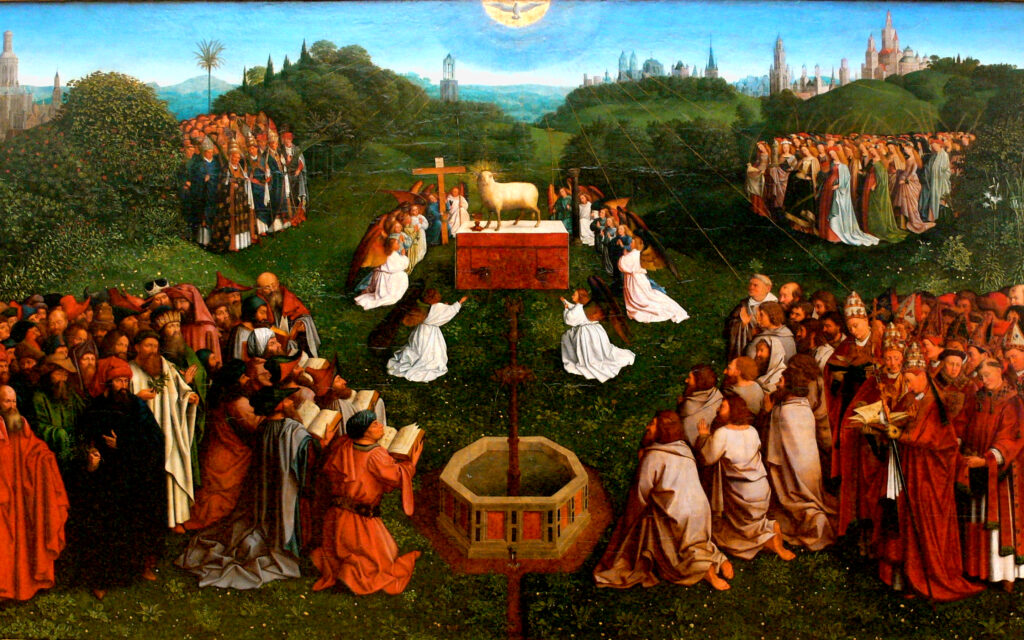[Greek] ἄμωμος (amōmos), [Latin] inmaculati, [Latin] non habentam maculam: without blemish, unblemished, without blame, spotless, faultless, without fault; Eph.1:4, Eph.5:27, Col.1:22, Heb.9:14, 1Pet.1:19, Jud. 1:24, Rev.14:5

Adoration of the Mystic Lamb: painting by Hubert and Jan van Eyck (1430). This is part of the Ghent Altarpiece at St. Bevo Cathedral in Ghent, Belgium.
Background information:
Adoration of the Lamb: The martyrs are shown in the top left. The pagan writers and Jewish prophets are shown in the bottom left. A fountain (symbol of eternal like) is shown in the bottom center. Apostles are shown in the bottom right. Behind the Apostles are the Church authorities. Virgins are shown on the top right. The Lamb, whose blood is spilling in a chalice, stands on the altar. Angels adore the Lamb. The angels are carrying the symbols from the Passion (the cross, the spear, the spear that held the sponge, and the pillar of the flagellation). The dove, representing the Holy Spirit, is at the top center.
Greek Hellenism: This term means one who is without approach (physically and morally) , blameless, without blemish, perfect, and unimpaired. Herodotus’ The Histories 2.177 states “Solon the Athenian got this law from Egypt and established it among his people; may they always have it, for it is a perfect law.” Hesiod’s Theogony 259 states “And, Euarne, lovely of shape and without blemish of form.” Aeschlylus’ Persians 185 states “I dread that two women in beautiful clothes, one in Persian garb, the other in Dorian attire, appeared before my eyes; both far more striking in stature than are the women of our time, flawless in beauty, sisters of the same family.”
Old Testament: This term means without defect, blameless, perfect (physical and moral), right (genuine), and entire (full). This term refers to God’s blamelessness Himself and of things of God. This term also refers to the perfect qualities needed for spotless animal sacrifices and priest qualifications. “The lamb must be a year-old male and without blemish (Exo.12:5). Noah, a good man and blameless in that age (Gen.6:9). The Rock-how faultless and are His deed, how right all His ways (Deut. 32:4). God’s way is unerring, the promise of the Lord is fire-tried (2Sam.22:31). As and oblation to the Lord, he shall present the fat of the peace offering: the whole fatty tail (Lev.3:9). Now, therefore, fear the Lord and serve Him completely and sincerely (Jos.24:14). You shall count seven full weeks (Lev.23:15).
New Testament: This term means without blemish and blameless. Christians, having received numerous blessings from Christ, are called to be holy in being without blemish. Paul calls husbands and wives to be holy (without blemish) in relationship to each other, like Christ’s relationship with His Church. Paul reminds the Colossians that they have been reconciled by Jesus’ unblemished body. Jesus, the unblemished high priest, enters into the sanctuary of heaven. Jesus is the unblemished sacrificial lamb. Companions of the lamb, not deceiving nor denying Christ, are unblemished. The power of God is needed to keep you unblemished, in not falling or stumbling.
Scripture:
“As He chose us in Him, before the foundation of the world, to be holy and without blemish before Him.” Eph.1:4
Christians have received numerous benefits from Christ. With this comes the call for holiness as adopted sons and daughters of God.
“How much more will the blood of Christ, who through the eternal spirit offered Himself unblemished to God, cleanse our consciences from dead works to worship the living God.” Heb.9:14
Christ, the unblemished high priest, enters the true heavenly sanctuary. He remains there permanently.
“But with the precious Blood of Christ as of as spotless unblemished lamb.” 1Pet.1:19
Jesus becomes the perfect sacrificial Lamb.
Macula: A macula is a spot, blemish, or stain. The macula is the central area of the retina which gives us the ability to see ‘20/20’. Macular degeneration can result in blindness.
Conclusion:
Immaculate, macula
In Greek Hellenism, this term also conveys the notion of someone who is without approach (physically and morally). It is interesting to note that this term speaks of purity in character. There are references to physical beauty. Herodotus also makes reference to the perfection in a law.
In the Old Testament, this term starts with God’s absolute blameless and of things with God. This term also refers to the perfection of qualities needed for a priest and animal sacrifices needed for sacrifices.
In the New Testament, Jesus becomes the more perfect and unblemished (spotless) sacrificial Lamb. Christ is the unblemished High Priest able to enter the sanctuary of heaven. Christians, receiving blessings from Christ, are called to be holy and without blemish. Paul calls husbands and wives to be in a strong mutual love in relationship to each other. This marriage should be likened to the relationship between Christ and the Church.
We also must not forget immaculate Mary who is without reproach. Mary is the new Ark of the Covenant who provides an unblemished place for Jesus to be born. The Church is absolutely “spot on” (exactly right) in celebrating Mary.
This is plain to see!
